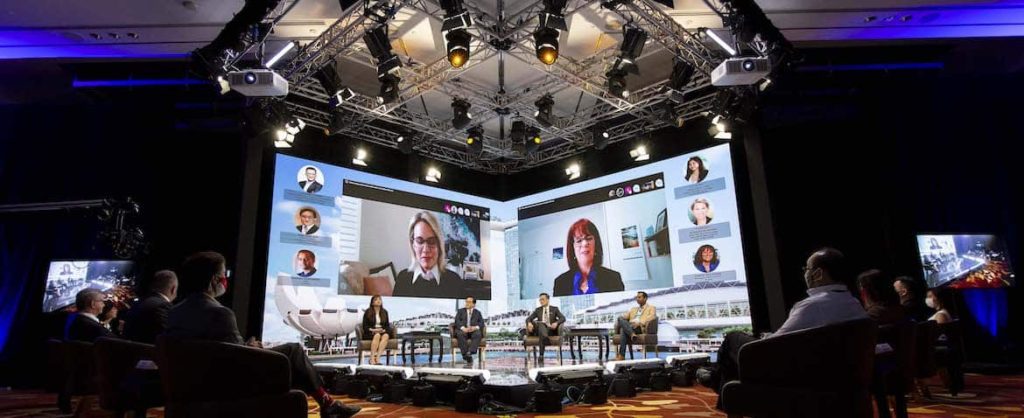Following up on our blog on how to host successful virtual events, we’re looking at the future of virtual events and why adopting a hybrid model is the best bet for a safe future. With digital fatigue rising, and most people hoping for a break from Zoom once in a while, your audience must have options.
Some event attendees and exhibitors miss the face-to-face interaction made possible during in-person tradeshows and conferences. Yet, the cost savings and ease of automated data collection during virtual events have proven useful. Rather than simply setting up a Zoom link for your event, a knowledgeable tech support team can help retrieve this data post-event so that sales and marketing teams can deploy a personalized follow up or send attendees more of the content related to what they engaged with during the event. This data is also great for event organizers to measure the ROI of the event and if it is worth more investment in the future. As virtual and hybrid events become more sophisticated, so too will your need for an informed tech support team.
Although we don’t expect onsite corporate events to make a complete return soon, there are ways to bring an audience what they want without compromising safety or quality. A hybrid model can serve the needs of both. Over the last year, many businesses learned that technology could either make the experience unforgettable or regrettable. Here is what to consider for a successful hybrid event.
Determine the goal
It might not always make sense to have a virtual component to an event. In other cases, a virtual element will boost your in-person event.
A virtual component is best for events where onsite spaces have capacity limits or you need to reach an international audience, such as global offices outside of headquarters. With travel and budget restrictions still ongoing, joining from a local office might be best. The following types of events work well with a virtual component:
- Trade shows
- Conferences
- Sales/Company Kick-off meetings
- Town halls
Gather the tools
You will need to choose the right in-person tools and the right virtual tools for a hybrid event. Choose a streaming platform or event technology software that meets your needs for the particular event. Consider the technology’s intuitiveness, the audio and video quality, and the number of attendees you expect. Some streaming platforms even offer data and analytics on what your attendees are interested in learning or interacting with and how they should be followed up with post-event.
Decide on the space you will hold the in-person portion of your event and consider the technical limitations or possibilities involved. Remember that the presentations, panels, networking, and breakout activities you facilitate there will also be streamed for your virtual audience, or you will need to create a similar virtual experience.
Prepare and designate tech support
Ask your speakers to provide their presentations or other content to you ahead of time to test on the streaming platform or event technology you choose. Pre-recorded presentations (with a live Q&A afterward) tend to have better quality audio and video and an overall higher production value than a livestream. Make sure that your event tech support is also familiar with the streaming platform.
Having a designated technology partner help with preparation ahead of time will ensure the event goes smoothly. If technical issues arise, they can help troubleshoot those issues and quickly resolve them. No matter the level of preparation, technical difficulties happen, so having a team or person on call for the event is helpful. This is one of the benefits of having onsite AV tech support.
While hybrid events might be a holdover until live events can come back in full swing, they could be here to stay, at least on some level. They allow for better attendance by making it convenient for people to join or watch on-demand, reach audiences on a global scale, provide better attendee data for marketing purposes, and save costs. A hybrid model can offer the best of both worlds.



